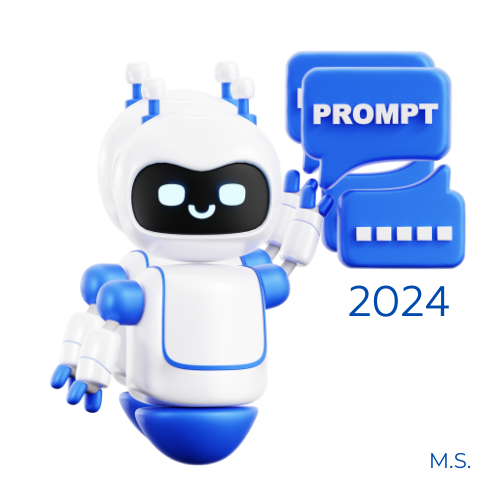In today’s rapidly evolving world of artificial intelligence, how we interact with AI assistants is crucial to unlocking their full potential. The perfect prompt is essential for obtaining desired outputs and achieving specific goals. In this blog post, we’ll dive into prompt stacking. This powerful technique enables you to create highly effective prompts tailored to your needs. By mastering the art of prompt stacking, you can guide your AI assistant to deliver accurate, relevant, and valuable responses. So, let’s embark on this journey together and discover how prompt stacking can revolutionize the way you work with AI.

Understanding the Basics of Prompt Stacking
Before we delve into the intricacies of prompt stacking, let’s establish a solid foundation by understanding the basics of prompts. A prompt is a set of instructions or questions that you provide to an AI assistant to guide its response. Prompts are crucial in determining the quality and relevance of the AI’s output. Effective prompts typically share common elements, such as clarity, specificity, and context. By crafting clear, concise, and well-defined prompts, you can help your AI assistant understand your intentions and generate responses that align with your expectations. Remember that the more information you provide in your prompt, the better equipped the AI will be to deliver accurate and valuable results.
The Prompt Stacking Technique
Now that we’ve covered the basics of prompts, let’s explore the concept of prompt stacking in greater detail. Prompt stacking is a technique that involves layering multiple instructions or prompts on top of each other to create a more comprehensive and targeted prompt. By stacking prompts, you can provide your AI assistant with a clear hierarchy of instructions, allowing it to process and respond to your request more structured and effectively. The benefits of prompt stacking include improved accuracy, more tailored responses, and the ability to handle complex tasks easily. To implement prompt stacking, follow these step-by-step guidelines:
- Start with a base prompt that outlines your request’s general purpose or objective.
- Identify specific subtasks or components that must be addressed within the main objective.
- Create individual prompts for each subtask, providing detailed instructions and examples.
- Stack these individual prompts on top of the base prompt, ensuring a logical flow and hierarchy.
- Review and refine your stacked prompt, ensuring it is clear, concise, and comprehensive.
By following these steps, you’ll be well on your way to creating powerful, stacked prompts that unlock your AI assistant’s full potential.
Identifying Your AI Assistant’s Purpose
Before you start crafting your prompts, it’s essential to have a clear understanding of your AI assistant’s purpose. What specific tasks or objectives do you want your AI assistant to accomplish? Are you looking for support in customer service, content creation, data analysis, or some other domain? A well-defined purpose will help you align your prompts with your desired outcomes, ensuring that your AI assistant delivers relevant and valuable results that meet your needs.
Take some time to reflect on your goals and expectations. Consider your specific challenges and how an AI assistant can help you overcome them. Once you have a clear picture of your AI assistant’s purpose, you can craft prompts tailored to your unique requirements.

Crafting the Base Prompt
The base prompt is the foundation upon which you’ll build your stacked prompts. It serves as your AI assistant’s starting point, providing a general understanding of your goals. A strong base prompt should include essential components such as a clear objective, relevant context, and any necessary background information.
When crafting your base prompt, aim for clarity and conciseness. Use simple, straightforward language that is easy for your AI assistant to understand. Avoid ambiguity or vague instructions that could lead to confusion or misinterpretation. Instead, be specific about what you want your AI assistant to do and provide any relevant details that will help guide its response.
Here are a few tips to keep in mind when creating your base prompt:
- Start with a clear, concise, objective statement outlining the main task or goal.
- Provide relevant context or background information that helps frame the task.
- Use specific language and avoid jargon or technical terms that may be unfamiliar to the AI.
- Keep the prompt focused and avoid including unnecessary details or tangential information.
By crafting a strong base prompt, you’ll lay the groundwork for effective, prompt stacking and set your AI assistant up for success.
Adding Layers to Your Prompt
With a solid base prompt in place, it’s time to start adding layers to it through iteration. Prompt stacking is an iterative technique that involves refining and expanding prompts to provide more specific instructions and cover a wider range of scenarios.
One effective way to add layers to your prompt is to include examples and edge cases. Examples help illustrate your expectations and provide your AI assistant with concrete references. Edge cases, on the other hand, challenge your AI assistant to handle unusual or complex situations that may not be covered by the base prompt alone.
When adding layers to your prompt, consider the following techniques:
- Break down complex tasks into smaller, more manageable subtasks.
- Provide step-by-step instructions for each subtask using clear and concise language.
- Include specific examples that demonstrate the desired output or behaviour.
- Anticipate potential edge cases and guide how to handle them.
- Use formatting techniques like bullet points or numbered lists to organize your prompts.
As you iterate and refine your prompts, remember that the goal is to create a comprehensive and effective prompt that guides your AI assistant to deliver the results you need.

Testing and Refining Your Prompt
Crafting the perfect prompt is an ongoing process that requires testing and refinement. Once you’ve stacked your prompts and added layers of instructions, it’s crucial to put your prompts to the test and evaluate the AI’s responses.
Testing your prompts involves providing your AI assistant with the stacked prompt and assessing the quality and relevance of its output. Compare the generated responses against your expected outcomes and evaluate whether they meet your criteria for success. If the reactions fall short or deviate from your expectations, it’s time to make adjustments and refine your prompts.
When refining your prompts, consider the following strategies:
- Identify areas where the AI’s responses are lacking or inconsistent.
- Clarify any ambiguous or vague instructions that may be confusing.
- Add specific examples or edge cases to help guide the AI’s behaviour.
- Rearrange or reorganize the order of your prompts to create a more logical flow.
- Solicit feedback from others and incorporate their insights into your prompt revisions.
Remember, refining your prompts is an iterative process. Several rounds of testing and adjustment may be necessary to achieve the desired results. Be patient, persistent, and open to feedback as you create the perfect prompt for your AI assistant.
Best Practices for Prompt Stacking
To make the most of the prompt stacking technique, it’s essential to follow best practices that ensure your prompts are effective, efficient, and aligned with your goals. Here are some key considerations to keep in mind:
- Keep prompts focused and specific: Do not overload your prompts with too many tasks or instructions. Instead, focus on one primary objective and break it into clear, specific subtasks.
- Maintain consistency in tone and style: Your prompts should have a consistent voice and style throughout. Use similar language, formatting, and structure across all layers of your prompt to create a cohesive experience for your AI assistant.
- Regularly review and update prompts: Your needs and goals should evolve, as should your prompts. Please review and update your prompts regularly to remain relevant and practical. Incorporate new examples, edge cases, or instructions to keep your AI assistant performing at its best.
- Keep prompts concise and easy to understand: While providing detailed instructions is important, avoid overly lengthy or convoluted prompts. Aim for concise, easy-to-understand language that lets your AI assistant grasp the task quickly.
- Test prompts thoroughly: Always test prompts thoroughly before deploying them in real-world scenarios. Evaluate the AI’s responses and make necessary adjustments to ensure optimal performance.
By following these best practices, you can ensure that your prompt stacking efforts yield the best possible results and maximize the potential of your AI assistant.
Real-World Examples of Effective Prompt Stacking
To better understand prompt stacking’s power and potential, let’s explore some real-world examples of how this technique has been successfully applied in various industries and applications.
Example 1: Customer Support Chatbot A company implemented prompt stacking to create an AI-powered chatbot for their customer support system. The base prompt outlined the chatbot’s primary objective of providing helpful and accurate responses to customer inquiries. Subsequent prompts included specific instructions for handling common questions, troubleshooting techniques, and escalation procedures. By stacking these prompts, the chatbot was able to provide comprehensive and tailored support to customers, resulting in improved satisfaction rates and reduced response times.
Example 2: Content Creation Assistant A marketing agency used prompt stacking to develop an AI assistant for generating engaging and SEO-friendly content. The base prompt specified the desired tone, style, and target audience for the content. Additional prompts covered keyword optimization, headline generation, and calls to action. By leveraging prompt stacking, the agency was able to create high-quality content at scale, saving time and resources while maintaining consistency across its marketing materials.
Example 3: Data Analysis Tool A financial institution created an AI-driven data analysis tool by stacking prompts. The base prompt defined the key metrics and insights the institution wanted to extract from its data. Stacked prompts provided instructions for data cleaning, normalization, and visualization. The resulting AI assistant quickly processed large volumes of data and delivered actionable insights, enabling the institution to make data-driven decisions and identify new growth opportunities.
These examples demonstrate the versatility and effectiveness of prompt stacking across different domains. By carefully crafting and layering prompts, businesses and individuals can unlock the full potential of their AI assistants and achieve remarkable results.

Conclusion
Mastering the art of prompt stacking is a game-changer for anyone looking to get the most out of their AI assistant. By breaking down complex tasks into clear, specific prompts and layering them in a logical hierarchy, you can guide your AI assistant to deliver accurate, relevant, and valuable outputs.
Throughout this blog post, we’ve explored prompt fundamentals, the prompt stacking technique, and best practices for crafting effective prompts. We’ve also seen real-world examples of how prompt stacking has been successfully applied in various industries and applications.
As you embark on your prompt stacking journey, remember to keep your prompts focused, consistent, and aligned with your goals. Test and refine your prompts regularly to ensure they remain effective and relevant. Most importantly, feel free to experiment and adapt prompt stacking to your unique needs and context.
By embracing the power of prompt stacking, you can unlock new possibilities for your AI-assisted workflows and achieve unprecedented efficiency, accuracy, and insight. So stack those prompts, and let your AI assistant propel you towards success!






